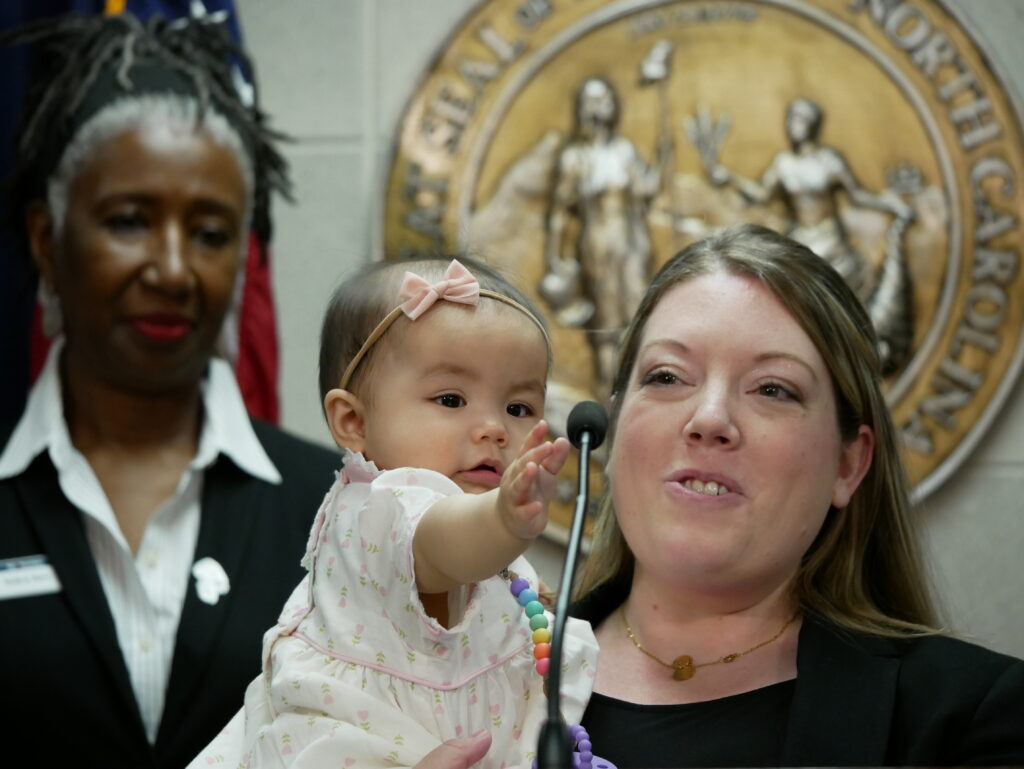Child care everywhere
Early Bird readers, hello again. Newcomers, welcome! If you were forwarded this email, you can sign up here to receive it every two weeks, and join our conversation on issues facing North Carolina’s young children and those who support them. If you’re already a subscriber, please help us reach more people by sharing this with your friends and co-workers interested in early childhood education.

It’s not every day you see an 8-month-old in the state legislative building. It’s even more rare to see one behind the podium in the press room. Yet Thursday was different, as bipartisan child care proposals took center stage at the General Assembly. In fact, this whole week was different.
As I covered the early childhood caucus bills filed Thursday — including a $300 million request to continue child care stabilization — the White House was releasing President Joe Biden’s budget proposal, which includes $600 billion in preschool and child care investments. A few days earlier, Gov. Roy Cooper delivered his final State of the State address. Guess what he spoke about? You guessed it: child care.
“It’s a triple play, guys,” Cooper said last Monday. “Education for the child, a job earning money for the parent, and a badly needed employee for the business.”
The five bills the caucus filed in both chambers last week would:
- Send a one-time $300 million to child care programs to support teacher compensation as federal stabilization funds run out.
- Raise the subsidy rates to the 2021 market rate survey results, and establish a subsidy floor rate (go here for what that means).
- Provide doula services and group prenatal care for mothers and babies on Medicaid and raise Medicaid rates for obstetric care providers.
- Establish a 3-county, 3-year pilot based on a model from Michigan that splits the cost of child care between employers, eligible employees, and state government.
- Rethink the state’s Quality Rating Improvement System (QRIS) for licensed child care programs.
What’s missing from this list?
Many advocates were hoping for the expansion of WAGE$, an education-based wage supplement program that incentivizes teacher retention. There will likely be a separate bill filed for this proposal, as it was brought up by a legislator at the caucus meeting Thursday.
Looking down the line, the proposals do not account for any new long-term funding stream for the early childhood system as other states have recently established. In that press conference, I asked what another one-time investment in child care would mean for the long-term.
Sen. Jim Burgin, R-Harnett, Lee, Sampson, co-chair of the caucus, answered: “Long-term, we have to figure something else out.”
These bills are simply filed for now. WRAL reporter Travis Fain asked Thursday if Republican leadership, absent from the press conference, were on board. Burgin and Rep. David Willis, R-Union, said the offices of Senate President Pro-Tempore Phil Berger, R-Rockingham, and House Speaker Tim Moore, R-Cleveland, have given them input and support.
“I can assure you that everyone at this point is concerned about the future of our youngest learners in the future of our workforce,” Willis said. “And so we’ve gotten full support from them on this. And this is a priority going through, as we’re speedily already going through the budget process that’s being talked about in both chambers.”
I’ll be looking into what we can learn from Michigan’s model and covering these bills as they move through committees. In the meantime, don’t hesitate to reach out with questions, story ideas, or just to connect.
Early Bird reads: What we’re writing
Q&A | Dogwood Health Trust on why to watch western NC for early childhood solutions
“I’m excited to see what happens when we continue to invest in those ideas and that innovation,” said Ereka Williams, vice president of education at Dogwood Health Trust, in an interview with EdNC on the foundation’s investments in early childhood workforce initiatives in the western region of the state.
Dogwood gave $8.3 million in December to 10 grantees to support current and future professionals working with young children. The organization will be creating recommendations for the state from its work with the grantees on how to strengthen the child care workforce.
North Carolina infants are more likely to die in their first year than the national average — especially if they’re Black
When it comes to death rates in the first year of life, the numbers have only slightly changed in recent years, but the story is the same: North Carolina’s rate in 2021 (the most recent information we have) was higher than the national average, and the disparity between Black and white infants is stark.
The 2021 rate — 6.9 deaths per 1,000 live births — was about the same as 2020’s rate of 6.8. The national 2021 rate was 5.4. But for Black babies in North Carolina, the rate was 12.1.
Cooper asks state’s congressional delegation for recurring child care funds
Gov. Cooper sent a letter to the state’s congressional delegation at the end of February asking for federal investment in child care.
“Thank you for the critical one-time funding during the pandemic but, as it ends, it’s important to know that the need is urgent,” Cooper wrote in a letter to Sens. Thom Tillis, R-N.C., and Ted Budd, R-N.C., and the 14 members of the state’s delegation to the U.S. House of Representatives.
In other early learning news: What I’m reading
To Tap Federal Funds, Chip Makers Will Need to Provide Child Care - From The New York Times
Black and Latino infants and toddlers often miss out on early therapies they need - From The Hechinger Report
New coalition seeks Colorado tax code changes to fund child care, education, nursing, and more - From Chalkbeat
Lawmaker wants to bar most early childhood school suspensions and expulsions - From New Mexico In Depth
How Countries Leading on Early Years of Child Care Get It Right - From Bloomberg
Research & Resources: Let's talk Private equity in child care
Capita, a nonpartisan think tank, released last week a brief on investor-backed for-profit child care chains by Elliot Haspel, who writes regularly about child care policy, including his 2019 book, “Crawling Behind: America’s Child Care Crisis and How to Fix It.”
“To date, the U.S. has not had a serious conversation about the threats posed by this profit-seeking subsector or potential policy actions to put guardrails around this model’s expansion,” Haspel writes in the brief’s introduction. “It is time for that to change.”
Haspel points out that these chains make a 15-20% profit while smaller independent programs struggle to stay open. He lays out potential threats as the sector grows: lower quality, risk of collapse, loss of independent community-based programs, furthering geographic and income inequalities, and harming the fight for a child care system that works for everyone.
He suggests action items such as more research on these issues, more guardrails and accountability for this subsector, and prioritization of public funding for nonprofit programs, community-based programs, cooperatives, and independent for-profit programs.
Sign up for Early Bird, our newsletter on all things early childhood.

